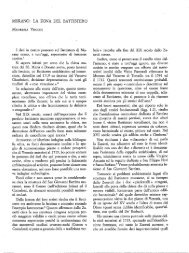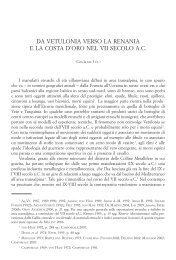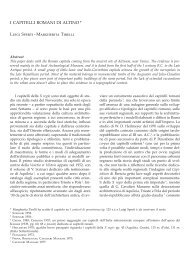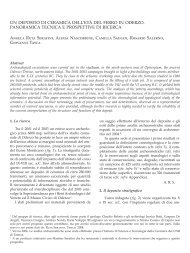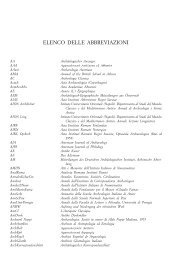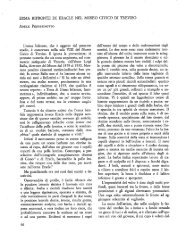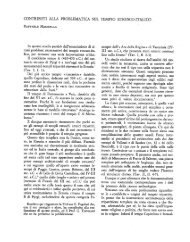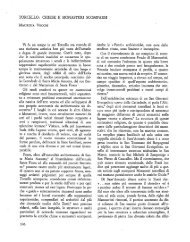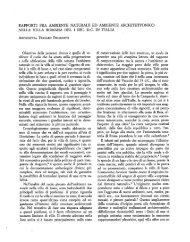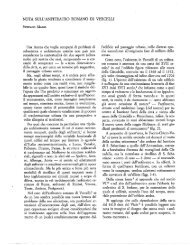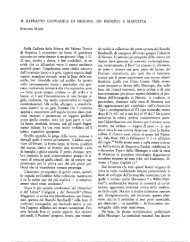RVApI,4/138. - Bretschneider Online
RVApI,4/138. - Bretschneider Online
RVApI,4/138. - Bretschneider Online
Create successful ePaper yourself
Turn your PDF publications into a flip-book with our unique Google optimized e-Paper software.
1981] SOME INTERESTING RED-FIGURE APULIAN VASES 78. BELL-KRATERPadua University, Museo di Scienze Archeologichee d’Arte MB144.(a) Woman with phiale and youth with thyrsus.(b) Two draped youths.The vase is known to me frorn photographswhich are poor; therefore the comments that follow are offered in a tentative way.The drawing recalls the style of the Dijon Painter on whom see <strong>RVApI</strong>, pp. 146; the vase maybe by his own hand. For the dense fold linesdrawn in pairs cf. the maenad on the bell-kraterBerkeley 8/3815, <strong>RVApI</strong>, 6/104 and the womanon the obverse of the bell-krater Matera 9690,<strong>RVApI</strong>, 6/107; for the youth with the thyrsuscf. Dionysos on the Berkeley bell-krater alreadymentioned. The draped youths on the reverse recail those on the Berkeley vase as well as theircounterparts on the bell-kraters Stockholm N.M. 16(<strong>RVApI</strong>, 6/109), Matera 9690 (<strong>RVApI</strong>, 6/107)and Naples Stg. 339 (<strong>RVApI</strong>, 6/139). The meander-pattern with saltire squares is typical of theartist (cf. the bell-krater Stockholm N.M. 16,<strong>RVApI</strong>, 6/109).Second quarter of the 4th century B.C.9. On~ocuo~ (type 3, chous)Rome, Pietro Rotondo Coilection 64.Head of Silen to the left with raised hand infront.Very dose to the Felton Painter, perhaps byhis own hand. On the Felton Painter see <strong>RVApI</strong>,pp. 172 ff. The yase is very similar to the chousno. 63 in the same collection (<strong>RVApI</strong>, 7/96d);it is one of a number of vases decorated with amale head or the head of a silen placed dose toeach other and dose to the Felton Painter.Second quarter of the 4th century B.C.10. HYDRIAGeneva Market (Nicolas Koutoulakis).Figs 13-16Scenè at naiskos: in the centre naiskos with astone «flower bud » in it; the podium of thenaiskos is decorated with a paimette and twolotus flowers. On the left, youth holding mirrorand phiale; on the right, woman holding ari openwreath. On the ground, phiale and wool basket.I don’t know any exact parallel to the « flowerbud» within the naiskos, but it obviously resembles the objects called by Lohmann «Balusterfbrmige Grabmiiier» (Hans Lohmann, Grabmiilerauf Unteritalischen Vasen, pp. 161 fE). ProfessorTrendail also brought to my attention the silveralabastron from tomb XXVI at Piceno (Hellenismus in Mittelitalien p. 165 and fig. 42) whichresembles these objects in shape.By the « Fiower Bud Painter ». Stylisticaliy ourvase stands very dose to the hydria GenevaMF 242, <strong>RVApI</strong>, 7/108 amI to the amphora Naples 2253 (mv. 81734), <strong>RVApI</strong>, 7/109. The threevases must be the work of a single artist whom Iname after the object in the naiskos on the newhydria. The facial features of the woman on ourvase resembie those of the right youths on theobserve and reverse of the Naples amphora (Pi.figs. 17-23) and her drapery recalls that of theseated wòman on the hydria Geneva FM 242 (notethe folds around. the waist). The three vases arealso closely linked by their maeander-patterns; andour vase and the Naples amphora are further connected by the fiorai ornaments under the handles.The connexion of the bell-krater York 21, <strong>RVApI</strong>,7/107 with the three vases attributed to the Flower-Bud Painter is clear, but I am not sure whetheì it should be attributed to the painter himself.In addition to being related to the Felton Painter,our artist is also reminiscent of the Iiiupersis Painter’s style, on whom sec <strong>RVApI</strong>, pp. 185 ff. Forthe importance of naiskos scenes in the work ofthe Iliupersis Painter see <strong>RVApI</strong>, pp. 186 ff.Second quarter of the 4th century B.C.il. On’~oci-io~ (type 3, chous)Addiphseck, Schloss Fasanerie 172.CVA 2, PI. 75, 4; A. D. Trendail, The Red-Figured vases of Lucania, Campania and Sicily, p. 180,no 1085.Satyr pouring wine from an amphora into asitula-like large vessel and maenad holding kantharos and branch.By the Painter of Athens 1680 on whom see<strong>RVApI</strong>, pp. 240 ff. The maenad is especially dosein style of drawing to the maenad on the obverseof the column-krater Ruvo 603, <strong>RVApI</strong>, 9/111.For the dotted quartered square of the maeanderpattern cf. the pelike in the Elis Jenkins Collectionin Neath, <strong>RVApI</strong>, 9/129. The vase was originally



